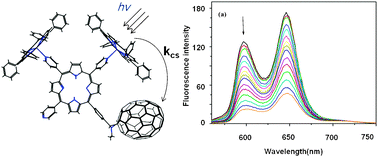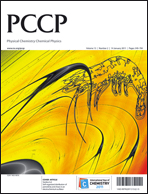A series of novel supramolecular complexes composed of a three-point binding C60-trispyridylporphyrin dyad (1) or C70-trispyridylporphyrin dyad (2) and zinc tetraphenylporphyrin (ZnP) were constructed by adopting a “covalent–coordinate” bonding approach, composed of three-point binding. The dyads and self-assembled supramolecular triads or pentads formed by coordinating the pyridine groups located on the dyads to ZnP, have been characterized by means of spectral and electrochemical techniques. The formation constants of ZnP-1 and ZnP-2 complexes were calculated as 1.4 × 104 M−1 and 2.0 × 104 M−1, respectively, and the Stern–Volmer quenching constants KSV were founded to be 2.9 × 104 M−1 and 5.5 × 104 M−1, respectively, which are much higher than those of other supramolecular complexes such as previously reported ZnP-3 (N-ethyl-2-(4-pyridyl)-3,4-fulleropyrrolidine). The electrochemical investigations of these complexes suggest weak interactions between the constituents in the ground state. The excited states of the complexes were further monitored by time-resolved fluorescence measurements. The results revealed that the presence of the multiple binding point dyads (1 or 2) slightly accelerated the fluorescence decay of ZnP in o-DCB relative to that of the “single-point” bound supramolecular complex ZnP-3. In comparison with 1 and 2, C70 is suggested as a better electron acceptor relative to C60. DFT calculations on a model of supramolecular complex ZnP-1 (with one ZnP entity) were performed. The results revealed that the lowest unoccupied molecular orbital (LUMO) is mainly located on the fullerene cage, while the highest occupied molecular orbital (HOMO) is mainly located on the ZnP macrocycle ring, predicting the formation of radical ion pair ZnP+˙-H2P-C60−˙ during photo-induced reaction.

You have access to this article
 Please wait while we load your content...
Something went wrong. Try again?
Please wait while we load your content...
Something went wrong. Try again?


 Please wait while we load your content...
Please wait while we load your content...